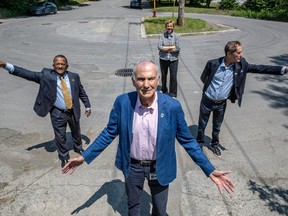Côte St-Luc city councillor Dida Berku says the suburbs have learned through recent exchanges with the city of Montreal that it’s now planning for the Cavendish extension to be composed of a bike path and tramway, and no mention of a road for cars.

After a year of signalling that it’s backing away from building the Cavendish Blvd. extension, the city of Montreal has told neighbouring suburbs that it’s studying options that don’t involve a road link, a representative of one of the suburbs says.
“We have found out through our queries to the urban planning department (of Montreal) that they’re working on alternative options to the Cavendish-Cavendish link, and the Cavendish-Cavendish road link is no longer being planned,” Côte St-Luc city councillor Dida Berku said this week.
“It’s a bike path and tramway instead.”
While the road link for cars and trucks hasn’t officially been declared dead, Berku said, “it’s now very clear.”
“We were told that … the road link itself is no longer being planned,” she said of the recent back-and-forth with Montreal civil servants.
A new project in the latest capital works program, labelled Namur-Hippodrome—Cavendish, includes Cavendish in name only, Berku contends, because there’s no money in it for Cavendish. In fact, the project description doesn’t mention Cavendish. And it describes the “principal intervention” in the short term as being the redevelopment of Jean-Talon St. W., where the Plante administration plans to add a bike path and a tramway.
The mayors of Côte St-Luc, Town of Mount Royal and the borough of St-Laurent, whose communities abut the land and railway tracks where the missing Cavendish link would be built, have denounced the omission and claim the city has reneged on its obligation to the province to budget for the Cavendish extension.
Berku said Cavendish proponents are preparing to launch a petition that will ask the Quebec government not to finance Montreal’s Hippodrome housing development without ensuring that the Cavendish-Cavendish link is back on track.
The plan to link the two ends of Cavendish in Côte-St-Luc and St-Laurent to relieve congestion on Décarie Expressway has been discussed for six decades. However, it became a contractual obligation for Montreal in 2017 when it signed an agreement with the Quebec government to transfer the 46-hectare former Hippodrome-Blue Bonnets horse racing track near Jean-Talon and Décarie Blvd. from the province to the city for housing development.
Yet the agreement to cede the Hippodrome land to Montreal was conditional on the city committing to building the Cavendish road link. One clause, for example, states: “The Cavendish-Cavendish link is a road that falls under its (Montreal’s) responsibility and it undertakes to include it in the agglomeration’s transportation plan and its three-year capital program.” (Montreal now has a 10-year capital program.)
Another clause calls on Montreal to take into account “the vehicular capacity of the Décarie Expressway” in developing the Hippodrome land and to include the Cavendish-Cavendish link.
The Plante administration and the city’s civil service didn’t respond to The Gazette’s questions.
Speaking to reporters at the unveiling of the Namur-Hippodrome plan this spring, Plante said the Cavendish link is still on, but not a priority to develop the Hippodrome site.
“I want to reassure everyone that what we call Cavendish-to-Cavendish is still in the plan, so it’s going to happen,” she said at the time.
“But what we have to do is (build it in phases). The first phase is to build Jean-Talon to Cavendish North.”
Still, traffic expert Rick Leckner said one lane is better than none.
“The city just clearly hasn’t kept its word and has gone back on it several times,” he said.
With the Royalmount mall set to open soon and condos going up around Décarie, Leckner said Cavendish is all the more necessary.
“A huge compromise is only one lane in each direction,” he said of Cavendish.
“But now it seems they’ve taken that out. For the sake of mobility, there absolutely must be a hybrid of public transit, vehicles and a lane for bikes.”